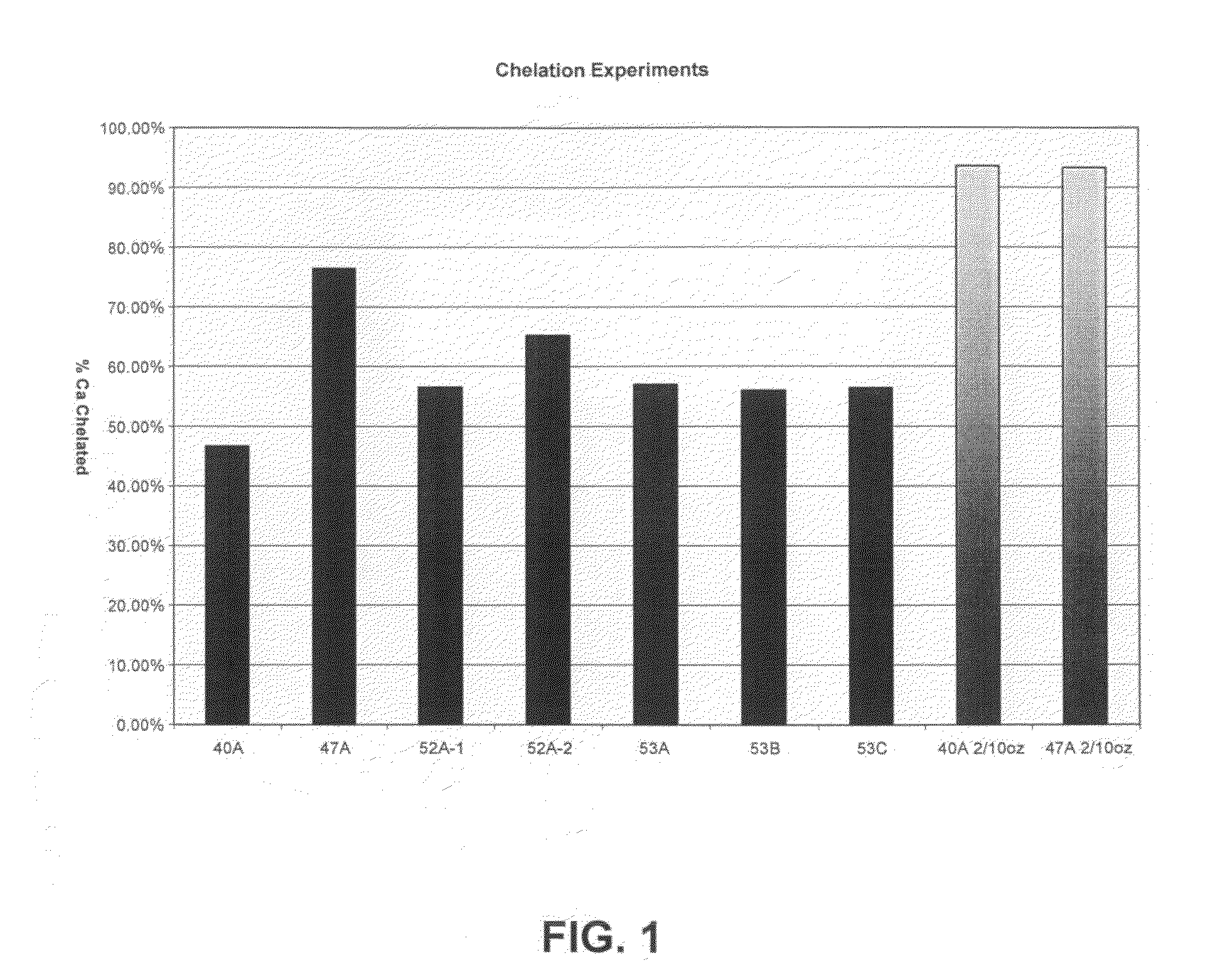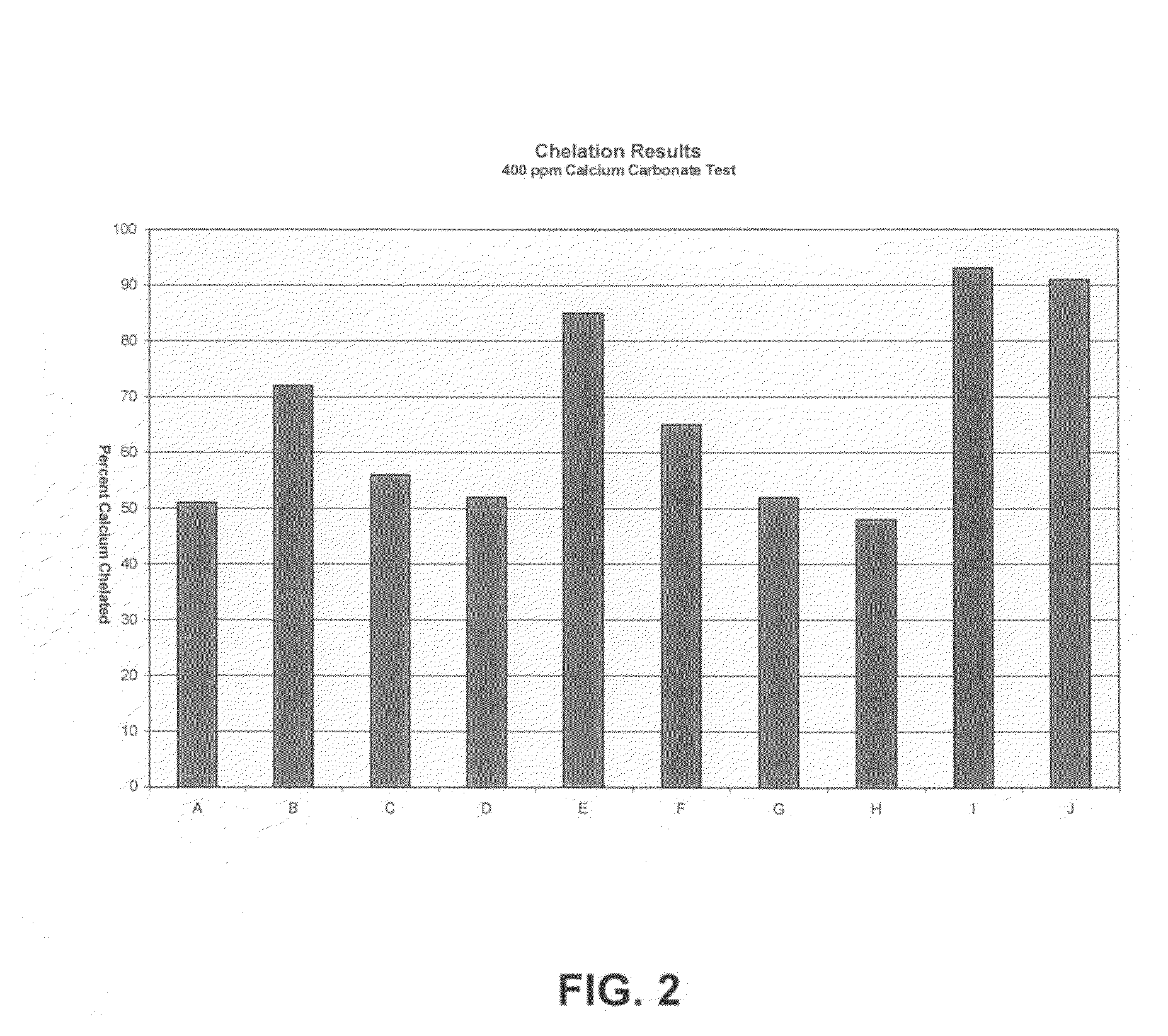Biodegradable scale control composition for use in highly concentrated alkaline hard surface detergents
a technology of alkaline hard surface detergent and composition, applied in the direction of cleaning using liquids, steering devices, cycle equipment, etc., can solve the problems of affecting the cleaning performance of instruments/equipment, presenting workers with safety hazards, and unable to sterilize alkaline cleaning compositions of the prior art, etc., to achieve superior scale inhibition and positive effect on cleaning performance of compositions
- Summary
- Abstract
- Description
- Claims
- Application Information
AI Technical Summary
Benefits of technology
Problems solved by technology
Method used
Image
Examples
example 1
[0086]Combinations of various chelants and sequestrants were evaluated. Table I sets forth the combinations tested. The combinations were each incorporated into a standard alkaline base that included an alkaline source, a surfactant system, corrosion inhibitors, and water. Test results provided information as to which combinations were most effective in preventing scale formation. The most efficacious combinations were A, B, C, D, F, I and L. These combinations were further modified and re-evaluated as set forth herein.
[0087]
TABLE IChelant Sequestrant CombinationsABCDEFGHIJKLChelantsAminotrimethylenexxxphosphonate @ 20%Imino disuccinic acid @ 15%xxxMethyl glycine diacetic acid @xxx15%[S,S]-ethylenediamine-N,N′-xxxdisuccinic acid @ 20%SequestrantsCarboxymethyl inulin @ 5%xxxxSodium Polyaspartate @ 5%xxxxPolyacrylic Acid @ 8%xxxx
example 2
[0088]Experiments were conducted to determine scale inhibition / control properties of various inventive formulations. Table II, below, lists the components, and weight % for each component for the inventive formulations tested.
[0089]
TABLE IIComponents wt %40A47A52A-152A-253A53B53CMGDA29.10%23.30%26.75%26.75%26.75%26.75%26.75%Polyacrylic Acid6.25%10.34%8.33%8.33%8.33%8.33% 8.33%Aminotrimethylene10.42%xPhosphonateSodium Hydroxide15.00%15.00%15.00%15.00%7.00%15.00%22.42%
[0090]The chelant / sequestrant combinations above were prepared in alkaline solution and evaluated for their combined efficacy in exceptionally hard water (i.e., >about 300 ppm as CaCO3. All of the formulations contained an alkylglucoside as a hydrotrope, and the balance was water.
[0091]All of the formulations were tested at 1 / 10 and 1 / 40 oz / gallon use-dilutions (in water). Two of the formulations (40A and 47 A) were also tested at 2 / 10 oz / gallon use-dilution. Results are set forth in FIG. 1, reflected as a percentage of...
example 3
[0092]Additional experiments were conducted to determine scale inhibition / control properties of various other inventive formulations. Table III, below, lists the components, and weight % for each component for the inventive formulations tested. The balance of all formulations is water. Each formulation was tested at 1 / 10 use-dilution and evaluated for their efficacy in exceptionally hard water. Although all of the formulations set forth in Table III exhibited some level of scale inhibition under the harsh (about 400 ppm CaCO3) water hardness conditions of the test, preferred efficacy was deemed to be at least about 70% of calcium chelated, which equates to handling exceptionally hard water.
[0093]
TABLE IIIComponent wt %ABCDEFGHIJMGDA17.0026.7526.7523.3023.3023.3023.3023.3021.1827.05Polyacrylic Acid10.008.3310.4210.4210.4210.4210.4210.4214.588.33Aminotrimethylene8.6210.3410.3412.0712.07phosphonateGLDA7.8912.50EDDS20.00Imino disuccinic acid7.147.14Sodium hydroxide15.0012.0010.0010.001...
PUM
| Property | Measurement | Unit |
|---|---|---|
| total weight | aaaaa | aaaaa |
| pH | aaaaa | aaaaa |
| compatibility | aaaaa | aaaaa |
Abstract
Description
Claims
Application Information
 Login to View More
Login to View More - R&D
- Intellectual Property
- Life Sciences
- Materials
- Tech Scout
- Unparalleled Data Quality
- Higher Quality Content
- 60% Fewer Hallucinations
Browse by: Latest US Patents, China's latest patents, Technical Efficacy Thesaurus, Application Domain, Technology Topic, Popular Technical Reports.
© 2025 PatSnap. All rights reserved.Legal|Privacy policy|Modern Slavery Act Transparency Statement|Sitemap|About US| Contact US: help@patsnap.com



